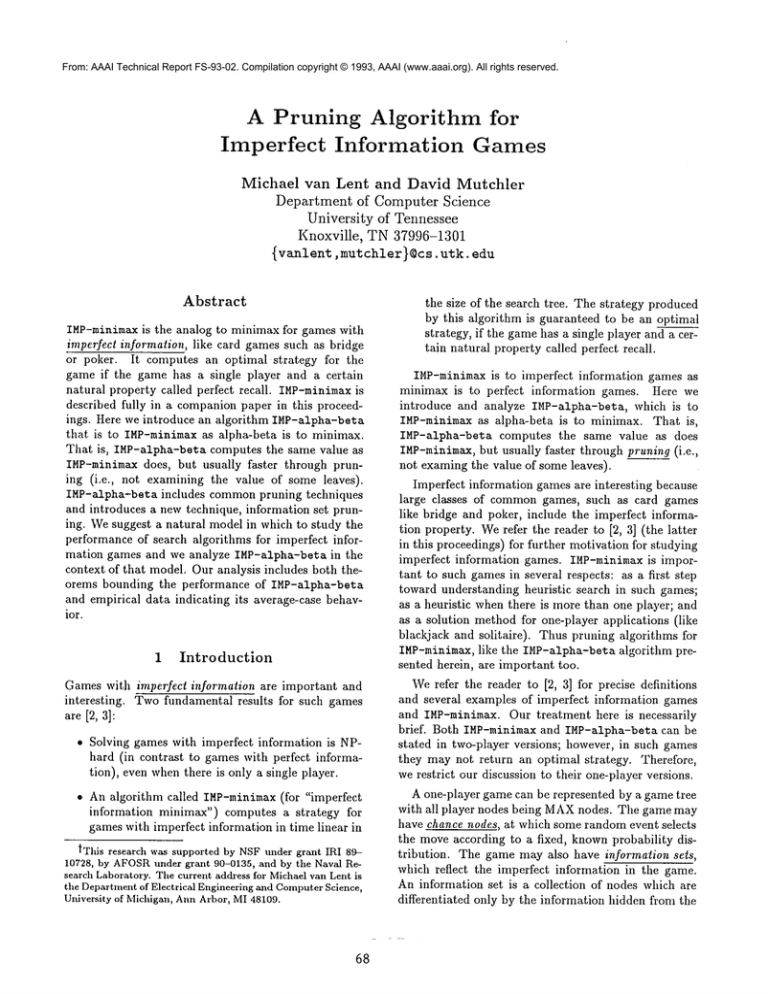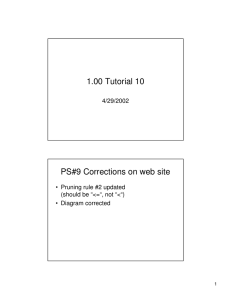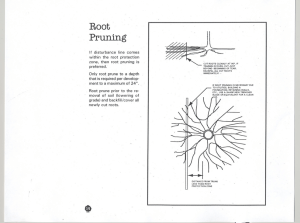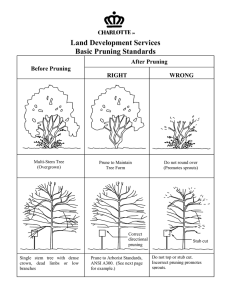
From: AAAI Technical Report FS-93-02. Compilation copyright © 1993, AAAI (www.aaai.org). All rights reserved.
A Pruning Algorithm
Imperfect Information
for
Games
Michael
van Lent and David Mutchler
Department
of Computer Science
University
of Tennessee
Knoxville,
TN 37996-1301
{vanlent, mutchler)Ocs, utk. edu
Abstract
IMP-minimaxis the analog to minimax for games with
imperfect information, like card games such as bridge
or poker. It computes an optimal strategy for the
game if the game has a single player and a certain
natural property called perfect recall. IMP-minimaxis
described fully in a companion paper in this proceedings. Here we introduce an algorithm IMP-alpha-beta
that is to IMP-minimax
as alpha-beta is to minimax.
That is, IMP-alpha-beta computes the same value as
IMP-minimax does, but usually faster through pruning (i.e., not examining the value of some leaves).
IMP-alpha-beta includes commonpruning techniques
and introduces a new technique, information set pruning. Wesuggest a natural model in which to study the
performance of search algorithms for imperfect information games and we analyze IMP-alpha-beta
in the
context of that model. Our analysis includes both theorems bounding the performance of IMP-alpha-beta
and empirical data indicating its average-case behavior.
1
Introduction
Games with imperfect information are important and
interesting.
Two fundamental results for such games
are [2, 3]:
¯ Solving games with imperfect information is NPhard (in contrast to games with perfect information), even whenthere is only a single player.
¯ An algorithm called IMP-minimax(for "imperfect
information minimax") computes a strategy for
games with imperfect information in time linear in
tTlfis research was supported by NSFunder grant IRI 8910728, by AFOSR
under grant 90-0135, and by the Naval 1Research Laboratory.The current address for Michaelvan Lent is
the Department
of Electrical Engineeringand ComputerScience,
University of Michigan,AnnArbor, MI48109.
68
the size of the search tree. The strategy produced
by this algorithm is guaranteed to be an optimal
strategy, if the gamehas a single player and a certain natural property called perfect recall.
IMP-minimax
is to imperfect information games as
minimax is to perfect information games. Here we
introduce and analyze IMP-alpha-beta, which is to
IMP-minimax as alpha-beta is to minimax. That is,
IMP-alpha-beta
computes the same value as does
IMP-minimax,but usually faster through pruning (i.e.,
not examing the value of some leaves).
Imperfect information games are interesting because
large classes of commongames, such as card games
like bridge and poker, include the imperfect information property. Werefer the reader to [2, 3] (the latter
in this proceedings) for further motivation for studying
imperfect information games. IMP-minimax
is important to such games in several respects: as a first step
toward understanding heuristic search in such games;
as a heuristic when there is more than one player; and
as a solution method for one-player applications (like
blackjack and solitaire).
Thus pruning algorithms for
IMP-minimax, like the IMP-alpha-beta algorithm presented herein, are important too.
Werefer the reader to [2, 3] for precise definitions
and several examples of imperfect information games
and IMP-minimax. Our treatment here is necessarily
brief. Both IMP-minimax and IMP-alpha-beta can be
stated in two-player versions; however, in such games
they may not return an optimal strategy. Therefore,
we restrict our discussion to their one-player versions.
A one-player game can be represented by a game tree
with all player nodes being MAXnodes. The game may
have chance nodes, at which some random event selects
the move according to a fixed, knownprobability distribution. The game may also have information sets,
which reflect the imperfect information in the game.
An information set is a collection of nodes which are
differentiated only by the information hidden from the
From: AAAI Technical Report FS-93-02. Compilation copyright © 1993, AAAI (www.aaai.org). All rights reserved.
q¢
6 1
6
3
2
7
5
Figure 1: A game with imperfect information.
player. Because tile nodes in an information set cannot be differentiated the player is required (by the rules
of the game) to select the same alternative for every
node in the information set. For example, the game in
Figure 1 has a chance node at the root and four information sets, denoted by the four ellipses. The leftmost
information set contains five nodes, with three alternatives from each. The player must either select the
left child from each of these five nodes, or the middle
child from each, or the right child from each; the player
may not (for example) select the left child from some
of the five nodes and the right child from others. This
reflects the imperfect information: the player does not
completely "know" the outcome of the chance node at
1the root.
Chess is a game of perfect information: the state
of the gameis described by the positions of the pieces
and whose turn it is, and this information is available
to both players. Backgammonis also a game of perfect information, but includes chance nodes: at certain
positions, the next position in the game is selected by
rolling the dice. The card game bridge is a game of
imperfect information. The first moveof the game is
to deal the cards at random. Each player knows the
contents of the player’s own hand, but the contents of
the other players’ hands are revealed only gradually, as
cards are played one by one.
In all our examples, we notate chance nodes by asterisks * and draw ellipses around the nodes in information sets. Further, at each chance node in our examples, the probability distribution associated with that
node is the uniform distribution (i.e., each alternative
1This simple example is not adequate
of information sets. See [2, 3] (the latter
more elaborate
examples and explanation.
for motivating
tile
in tlfis proceedings)
use
for
69
is equally likely).
A strategy is a prescription for what alternatives
to select at the player nodes. The quality of a
strategy is measured by its expected payoff, which,
in turn, depends on the probability of reaching leaf
nodes. Given a strategy
~r on a game tree, the
probability of node x under 7c, denoted p~(x), is defined
to be the product of the probabilities
of the arcs
on the path from the root to z, with each arc below a non-chance node granted probability 1 or 0 depending on whether or not ~r selects that arc. The
expected payoff under strategy re, denoted H(~r), is defined to be ~p~(w) h(w), where the sum is over all
leaves w in the game tree and h(w) denotes the payoff
at leaf w. For example, in Figure 1, an optimal strategy (i.e., one which maximizes the expected payoff)
to select the middle alternative from the leftmost information set and the rightmost alternative from the three
other information sets; this yields an expected score of
"~1+5+7+8+27
~Ar~.4 7
The value of a one-player gamewith imperfect, information is the value returned by IMP-minimax,
as described below. If the imperfect information game has
a certain property called perfect recall, then it can be
shown that its value (as computed by IMP-minimax)
equals the expected value of the optimal strategy [2, 3].
Informally, perfect recall means the player recalls her
previous moves; the technical definition can be found
in our companion paper in this proceedings [3]. Note
that perfect recall is not the same thing as perfect information.
From: AAAI Technical Report FS-93-02. Compilation copyright © 1993, AAAI (www.aaai.org). All rights reserved.
IMP-minimax:
call
v ( expand
( {root
ofthegame
tree}
where the recursive function V(X) takes a set X of
nodes in the game tree and is given by:
max{ V(extend (Y)) ] Y is a child of
if X is a PI-set
v(x) =
v(x) h(x)
x ~. partition
x a leaf
(X)
v(x)
x e partition
(X)
x a PI-set
otherwise
and where function expand takes a set of nodes and recursively replaces each chance node by its children; a
partial information set, abbreviated PI-sel, is a set of
nodes all of which belong to a single information set;
the jth child of a partial information set I is the set
of all immediate descendants of nodes in I reached via
the jth alternative; p(x) is the product of the probabilities below chance nodes on the path from the root
of the game to node z; h(z) is the payoff at leaf z;
and partition (X) separates the leaves from the nonleaves in X and partitions the non-leaf nodes into their
respective information sets. See [2, 3] (the latter in
this proceedings) for a more complete exposition of
IMP-minimax,including examples of its use.
algorithm .4 computes the same value for G and G’.
But this contradicts the correctness of .4 -- the value
of game G is at most Mand the value of game G’ is at
least M+lp = Jlg+l. II
P
Fortunately,
a simple assumption permits pruning in one-player games: suppose there is a known
upper bound on the payoffs at leaves. This assumption is quite reasonable in practice, and is also
used in multi-player pruning [5, 6] and chance-node
pruning [1]. ~,’Ve introduce a new form of pruning,
information set pruning, which assumes such an upper
bound. Before formally stating the IMP-alpha-beta
algorithm that implements this pruning, we show how
it works through examples.
Example 1 Consider the game tree in Figure 2, where
the upper bound on payoffs at leaves is 10. The left
alternative from the information set gives an average
payoff of_.2_ ~ = 8 while the right alternative can give
at most ~ = 6. Hence an algorithm which has determined the three values specified in the figure need
not examinethe subtree labeled ’ ’?. ’ ’
9
2
Information
set
pruning
Tile following theorem shows that in general pruning
is not possible in one-player gaines. Weassume for
the theorem that the probabilities at arcs below chance
nodes are all non-zero.
Theorem 1 Let ,4 be any algorithm that correctly
solves this problem: given a one-player game, return
the value of that game. Then for any one-player game
G given as input to algorithm ‘4, every leaf in G is
examined by ‘4. (That is, .4 determines the payoff of
every leaf in G.)
Proof (by contradiction). Suppose there were a correct algorithm .4 that determined the value of some
one-player game G without examining some leaf X of
G. Let Mdenote the maximum,over all leaves in G, of
the payoffs at those leaves. Let p denote the product of
the probabilities below chance nodes on the path from
Ithe root of G to node X. Construct a new game G
that is the same as G except that the payoff at leaf X
in G’ is M+I.
By choice of X and construction of G’,
P
7O
2
7
?
Figure 2: Information set pruning,
a simple example.
Information set pruning is available because the
value of an alternative A from an information set X is
the sum of the values of the leaves and/or information
sets into which X fragments via alternative A. (Confer
the second case in the V function for IMP-minimax.)
Knowingthe values of some elements of this sum, and
bounding the values of the other elements of the sum
by using the upper bound on payoffs at leaves, provides
an upper bound u on the value of X via alternative A.
If information set X is knownto have (via another alternative B) a value higher than u, then the remaining
terms of the sum can be pruned.
Example 2 Consider the game tree in Figure 3, where
again the upper bound on payoffs at leaves is 10. Let
T denote the top-level information set; it contains
13 nodes. The value of T via its left alternative is
From: AAAI Technical Report FS-93-02. Compilation copyright © 1993, AAAI (www.aaai.org). All rights reserved.
0244
449070???.7?77??????
Figure 3: Information set pruning, a more elaborate example.
8+...8 = 8. The value of T via its right alternative
13
is the weighted sum of the four information sets below
T and the leaf whosepayoff is 3. The first two of those
information sets have values max{-qi~-, 132+4} = 6/13
and max{4~947, 4+0+0~
= 20/13, respectively.
The
13
J
last two of those information sets have values at most
2~ and 5~, respectively. Hence the value of T via its
right alternative is at most ~3 + 3 +$5 + 2~ + 5y~,20 10
10
which equals 99/13, which is less than the value (8)
of T via its left alternative. Both of the forests below
the rightmost two information sets at depth 2 can be
pruned.
As in alpha-beta pruning, the source of the pruning
bound for information set pruning can be either one
level above the pruned nodes (shallow pruning) or many
levels above the pruned nodes (deep pruning). Here
an exampleof the latter.
Example 3 In the game tree in Figure 4 (again with
10 as the upper bound on payoffs at leaves), the node
marked ?? can be pruned. This happens not because
the left child of its parent information set has value
94+1 = 5/2, nor because the left child of its grandparent information set has value 7+0
= 7/4, but rather
4
because the left child of its great-grandparent information set has value 848+84s
_ 8. As we will see,
4
IMP-alpha-beta propagates this value (combined with
other pruning information) down to the bottommost
information set, where the pruning of node ?? occurs.
Information set pruning is different from alpha-beta
pruning [4, 8], which requires both MAXand MIN
nodes. Because our games have only a single player,
alpha-beta pruning is available to us only in the weak
form of immediate pruning: if the value of one alternative from an information set equals the highest
value possible, then the remaining alternatives can be
pruned. Information set pruning is more closely related to chance-node pruning [1], although the two are
71
8
5
??
Figure 4: Information set pruning, deep pruning.
by definition not the same, since chance-node pruning
operates at chance nodes while information set pruning
operates at collections of information sets that may be
far removed from any chance nodes.
Algorithm IHP-a:].pha-beta appears in the box at
the top of the next page. Domain-specific functions
are italicized and explained below. Scoping is indicted
by indentation. Note that the two subfunctions call
each other recursively, with the recursion ending in
H±xed-Set. Function Ha.x-Set takes a set of game-tree
nodes, all of which are contained in a single information set. Function H:i.xed-Set also takes a set of nodes,
but the set may contain leaves and/or nodes from more
than one information set.
The behavior of most of the domain-specific functions is clear from their names: alternative finds the
alternatives from an information set; move returns the
nodes obtained from following a given alternative from
From: AAAI Technical Report FS-93-02. Compilation copyright © 1993, AAAI (www.aaai.org). All rights reserved.
IMP-Mpha-beta: call
Mixed-Set (expand ({root}),-oo).
Max-Set(x,P)
best = P
for each alternative A from x
temp= Mixed-Set
(expand
(move
(A, x)),
best)
if temp > best
if temp == U * prob (x)
return (temp)
best -- temp
return (best)
Mixed-Set(X, P)
sum---- 0
prob-left = prob (X)
X := partition (X)
for each member x of X
prob-left = prob-left - prob (x)
if xisaleaf
sum = sum + prob (z) * payoff (x)
else
P-sumsum=sum+Max-Set
(x,
if sum + U * prob-left < P
return (P)
return (sum)
a given information set; payoff returns the payoff of the
given leaf; root refers to the root of the given gametree;
and U is an upper bound on payoffs at leaves. The
other three domain-specific functions are drawn from
IMP-minimaxand defined as follows:
¯ prob takes a node or set of nodes. On a node x,
it returns the product of the probabilities below
chance nodes on the path from the root to node x.
On a set of nodes, it returns prob (z) summedover
all nodes x in the set.
¯ expand takes a set of nodes and recursively replaces
each chance node by its children, until no chance
nodes remain.
¯ partition takes a set of nodes in the gametree and,
after separating the leaves from the non-leaves,
partitions the non-leaves into their respective information sets. It returns the set that results; each
memberof the set is either a leaf or a subset of an
information set. For example, if the thirteen depth
3 nodes in Figure 3 are labeled a, b...m (left to
right), then partition applied to the set of those
thirteen nodes yields
{ {a,b}, c, {d,e,f}, {g,h}, {i, j, k, l, m}}
72
U*prob-left)
Theorem 2 (IMP-alpha-beta
is correct)
For any real number P and set X of nodes in a oneplayer game with imperfect information,
Mixed-Set(expand (X),
=
V(expand
(X))
p
if V(expand (X))
otherwise
In particular,
IMP-alpha-beta
computes the same
value as IMP-minimax.
Proof: by induction on the number of recursive calls
to V. See [7, 9] for details. II
To obtain the strategy associated with the value
IMP-alpha-beta returns, simply record in Max-Set the
alternative with which best is associated. An efficient
implementation of IMP-alpha-beta must make various
constant-time optimizations.
3
The
IMP-model
Any analysis of the effectiveness of IMP-alpha-beta
requires a general model of one-player games with imperfect information. In particular,
one must extend
current models to include information sets. The IMP-
From: AAAI Technical Report FS-93-02. Compilation copyright © 1993, AAAI (www.aaai.org). All rights reserved.
w
Figure 5: The IMP-modelwith k = 3, b = 2 and d = 3.
model proposed here is motivated by real games, flexible enoughto generate a wide variety of trees, yet simple to generate and analyze.
The IMP-model has three positive integers as parameters: k, b and d. Each game tree within the model
has a single chance node, at the root of the tree. This
chance node has k d-1 children all within a single information set. Each interior node of the game tree, except
for the root, has b children. For each information set
X in the game tree, the jth child of X (for j from 1 to
b) is partitioned into k information sets of equal size;
however, depth d nodes are leaves. The IMP-modeldescribes only the structure of the gametree. Payoffs can
be assigned by whatever method is desired. Figure 5
shows an example of the IMP-model.
exampleis card counting, that is, calculating the probability that a certain card will be on top of the deck
based on knowledge of which cards have already been
played.
4
Effectiveness
of IMP-alpha-beta
How much faster
is IMP-alpha-beta
than
IMP-minimax? This section addresses that question,
in the context of the IMP-model.
Following standard practice, we measure the "speed"
of IMP-minimax and IMP-alpha-beta by the number
of leaves examined by each. This is reasonable, since
IMP-minimaxis essentially a tree traversal, evaluating
leaves when encountered, and IMP-alpha-beta can be
implemented on top of IMP-minimaxwith little overhead.
For a given IMP-model game tree, the number of
leaves examined by IMP-alpha-beta depends on several factors: the payoff values; the placement of these
values; and the orderings of the loops in Max-Set and
Mixed-Set. (That is, in what order should the b alternatives in Max-Set be searched, and in what order should the k leaves or partial information sets in
Mixed-Set be searched?) This section presents both
theorems and experiments to explore the space of possible values for these factors. For brevity we omit the
proofs of the theorems; they can be found in [7, 9].
The novelty of the IMP-model is in its method for
specifying the information sets, via the parameter k.
Each information set fragments into k information sets,
along each alternative. Thus k specifies how much"information" the player gathers at each step of the game.
For example, when k is 2, each information set is half
as large as its parent information set, reflecting information gained at that move;the player also gains information by remembering which alternative she selected.
The k = 1 tree has perfect information.
The IMP-modelis motivated by two very basic properties of card gaines: shuffling the deck and discovering
additional information at each move. The chance node
at the root of the IMP-modelcorresponds to dealing
from a shuffled deck of cards, a first step in manycard
games. The fragmentation of each information set into
k information sets along each alternative mimics the
gradual process of revealing hidden information, until
the end of the game when everything is revealed. For
example, in bridge and many other card games a single card is revealed at each move. By observing which
cards are revealed a good player not only learns what
cards were held but also guesses what cards the opponent may or may not still have. (Although bridge is
a two-team game, IMP-alpha-beta may still be useful
for it, as a heuristic or subfunction [2, 3].) Another
Theorem 3 IMP-minimax
examines all (kb) d-1 leaves
in the IMP-modeltree.
4.1
Boundaries
The following theorem provides both upper and lower
bounds on the amount of pruning available in the IMPmodel.
Theorem 4 For any setting of the parameters (h, b,
and d) of the IMP-modelwith k > 1, and for any order-
73
From: AAAI Technical Report FS-93-02. Compilation copyright © 1993, AAAI (www.aaai.org). All rights reserved.
ing of the loops in IMP-alpha-beta, there exist payoff
values and placements such that the number of leaves
2examined by IMP-alpha-beta can be:
¯ as manyas (kb) d-1 (that is, no pruning).
¯ as few as k d-1. (Further, this lower bound is tight
-- at least this many nodes must be examined.)
¯
as few as
bd-l(b-
1)
-
ka-l(k
-
1) if k #
b-k
b(d-2) (bd - d 1)
if k = b
with none of the pruning due to immediate pruning.
Tim second result represents the extreme case when
all the examined leaves give the upper bound and the
rest of the tree is pruned through immediate pruning.
The second and third results in the above theorem show
that it is possible to prune vast portions of the game
tree, if the payoffs and placements are favorable, even
if the effects of immediate pruning are ignored. The
third result bears strong resemblance to the best-case
behavior of alpha-beta, in which approximately d/2
2b
leaves out of bd total leaves are examined [4]. When
k equals b, the above theorem shows that, in the best
case, fewer than dbd-1 leaves will be explored out of
b~(d-D total leaves.
4.2
Average case analysis
Theorem 4 gives upper and lower bounds on how much
pruning can be obtained by using IMP-alpha-beta.
This section provides a first attempt at determining
what pruning one might expect in practice. To that
end, we generated IMP-model trees with random leaf
payoffs and measured the average number of leaves examined by IMP-alpha-beta. Using random leaf payoffs
has flaws, but provides a reasonable first approximation
for the average case behavior of IMP-alpha-beta.
3Our code is written in Austin Kyoto Common
Lisp.
The experiments ran on a collection of Sun-4’s. At each
leaf encountered, we obtain its payoff from the built-in
function call (random 11), which yields an integer between 0 and 10, inclusive. For each trial we ran, we
2For brevity
recorded the initial state of the random number generator, so that our results can be reproduced. Our code
is available upon request, as is the record of random
payoffs.
Weconsidered all combinations of k and b from 2 to
10, as well as a few additional combinations (k = 2 and
b large). For each of these cases, we varied the depth
d from 2 to 5; additionally, we ran larger depths for
the smaller values of k and b. In all, we considered 427
combinations of k, b and d. For each such combination,
we ran multiple trials and averaged the results of the
trials. The number of trials varied from 3 to 5000 and
was chosen to insure that for every combination, a 95%
confidence interval for o~fl/ram was less than 1%(usually much less), where o~fl and ram are the number of
leaves examined by IMP-alpha-beta and IMP-minimax
respectively. The total run time used for the experiments was well over 200 hours.
The three main conclusions from the experiments are
as follows, where o~fl and ram are as just stated. First,
aft~ram decreases as the depth d of the tree increases,
but its limit as d ---* oo appears to be strictly positive in
all cases. Second, for fixed k and d, function aft/ram
decreases as b increases. Third, for fixed b and d, function afl/rara increases as k increases.
Figure 6 illustrates these conclusions, for k = 2 (left
graph) and b = 2 (right graph). In both graphs the
axis is the depth d and the y-axis is 100 aft~ram, where
aft and mra are as stated above. (Note the different
scales for the y-axes.) All the curves showthat o~fl/mm
is a decreasing function of d. Less than 20%of the total
nodes are examined in the more favorable cases (bottom
curve of the left graph, where b = 10 and k = 2).
About 96%of the total nodes are examined in the least
favorable case (top curve of the right graph, where b =
and k = 10).
In sum, the fraction examined by IMP-alpha-beta
of the total number of leaves is minimized when k is
small and b is large; this fraction decreases (but not
to zero) as the depth increases. Substantial pruning
can be achieved even for modest values of b and d, if k
is small. The overhead in a careful implementation of
IMP-alpha-beta
is small enough that IMP-alpha-beta
runs faster than IMP-minimax
when almost any pruning
is achieved, for static evaluators one would encounter
in practice.
4.3
Ordering
we onfit the k = 1 special case; it is given in
[7,91.
3Austin Kyoto ConmmnLisp is public domain software written by William Sclielter at the University of Texas, and is based
on Kyoto CommonLisp, written by Taiiclfi
Yuasa and Masazrd
Hagiya, Kyota University, 1984.
74
One would expect that at Max-Set, searching alternatives from best to worst is optimal, because high returned values create high pruning values, which in turn
makes subsequent pruning more likely. Likewise, one
From: AAAI Technical Report FS-93-02. Compilation copyright © 1993, AAAI (www.aaai.org). All rights reserved.
100
100
90-
40,
80-
20’
k=2 and b=2..lO
’
I
I
2
3
¯
I
4
’
I
5
b=2 and k=10..2
"
I
8
7O
’
7
I
I
2
3
g
I
4
¯
I
’
5
l
6
7
Figure 6:100 afllmm versus depth d, where aft and mmare the number of leaves
examined by IMP-alpha-beta and IMP-minimax respectively.
The curves in the
left graph are all for k = 2, with b varying from 2 (top curve) to 10 (bottom curve).
The curves in the right graph are all for b = 2, with k varying from 10 (top curve)
downto 2 (bottom curve). All data points are averages over enough trials so that
tile width of its 95%confidence interval is less than 1%.
would expect that at Mixed-Set, searching the leaves
or information sets from worst to best is optimal, since
low returned values in Mixed-Set increase the likelihood that the pruning condition succeeds. In fact, the
first of these expectations is true; the secondis false in
general, as shown by the following theorems.
the IMP-model and all payoff values and placement of
these values.
Theorem 5 For any setting of the parameters (k, b,
and d) of the IMP-model and for any payoff values
and placement thereof, the fewest leaves are examined
by IMP-alpha-beta if at Max-Set, the alternatives are
searched from best to worst. (In general, ties cannot be
broken arbitrarily.)
By "best alternative," we mean the
alternative for which the returned value is maximal.
Theorem 6 No ordering
sets in Mixed-Set that
values minimizes the
IMP-alpha-beta for all
of the leaves or information
depends only on the returned
number of leaves examined by
settings of the parameters of
75
The above contrasts with the analysis of alpha-beta,
where for every set of payoffs and placements thereof,
the best-first ordering yields as muchpruning as is possible, in uniformtrees [4].
5
Summary
and
open
questions
~Ve have introduced and analyzed IMP-alpha-beta,
a
pruning algorithm for IMP-minimax. Both algorithms
find optimal strategies in imperfect information games
that have a single player and perfect recall, and can be
used as heuristics in more general games. Future work
includes extensions of the IMP-alpha-beta algorithm
and its analysis:
From: AAAI Technical Report FS-93-02. Compilation copyright © 1993, AAAI (www.aaai.org). All rights reserved.
¯ Can more pruning be obtained through non-depthfirst strategies than from IMP-alpha-beta? When
information sets are present, not only is no fixed ordering optimal at Mixed-Set (Theorem 6), but the
entire depth-first strategy may need to be abandoned to minimize the number of leaves examined. Tile same is true whenonly chance nodes are
present, and motivates the "probing" in Ballard’s
pruning algorithms for perfect information games
with chance nodes [1]. Ballard’s technique can be
used for information set pruning as well; however,
the absence of MINnodes in our one-player games
appears to limit its usefulness.
¯ More powerful pruning may be obtained if the upper bound on payoffs at node x is required only to
bound payoffs at leaves below x, instead of payoffs at all leaves. Such upper bounds are readily
available in, for example, the card gamebridge.
¯ An interesting heuristic is to prune if the required
sum is "close enough" to the pruning bound. We
would expect this to magnify pruning significantly
in applications in which a few information sets
have large probability and the rest have small
probability.
¯ The best test for
IMP-alpha-beta is
plication, possibly
two-player game, as
the pruning effectiveness of
its performance in a real apas a one-player heuristic for a
described in [2, 3].
Acknowledgments
We appreciate the useful comments we received from
Jean Blair and the anonymousreviewers.
References
[1] Bruce W. Ballard. The *-minimax search procedure for trees containing chance nodes. Artificial
Intelligence, 21(1,2):327-350, March1983.
[2] Jean R. S. Blair, David Mutchler, and Cheng Liu.
Heuristic search in one-player games with hidden
information. Technical Report CS-92-162, Dept.
of Computer Science, University of Tennessee, July
1992.
[3] Jean R. S. Blair, David Mutchler, and Cheng Liu.
Gameswith imperfect information. In Proc. of the
AAAI Fall Symposium on Games: Planning and
Learning, Raleigh, 1993.
[4] Donald E. Knuth and Ronald W. Moore. An analysis of alpha-beta pruning. Artificial Intelligence,
6(4):293-326, Winter 1975.
[5]Richard
E. Korf. Multi-player alpha-beta pruning.
Artificial Intelligence, 48(1):99-111, February 1991.
Carol A. Luckhardt and Keki B. Irani. An algorithmic solution of n-person games. In Proc. of the
Fifth National Conference on Artificial Intelligence
(AAAI-86}, pages 158-162, Los Altos, CA, 1986.
Morgan Kaufmann Publishers.
[7]David
Mutchler and Michael van Lent. A pruning
algorithm for imperfect information games. Technical report, Dept. of ComputerScience, University
of Tennessee, September 1993.
[8]James
R. Slagle and John K. Dixon. Experiments
with some programs that search game trees. Journal
of the ACM,16(2):189-207, April 1969.
[9]Michael
van Lent. A pruning algorithm for one
player games with hidden information. Master’s
thesis, University of Tennessee, May1993.







